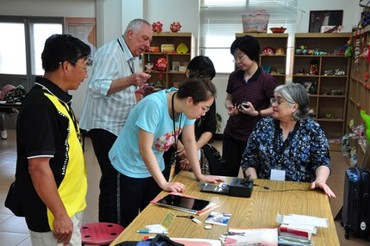AusHeritage presented a workshop program on Kinmen Island, Taiwan in late June/early July for the fourth year running with the China University of Technology CUTe), Taipei. The 2015 program focused on the theme of local knowledge, communities and community development. The partners in the project included the Cultural Affairs Bureau of Kinmen County, the National Quemoy University, the Cultural Heritage Institute of Kinmen and Kinmen National Park. The program was supported by the Bureau of Cultural Heritage, Ministry of Culture, Taiwan.
The first day on Kinmen began with a visit to the County Magistrate’s Office of Kinmen County Government and included an intensive program of site familiarizations, visits to the Kinmen National Park Office and various village settlements as well as the Lion Mountain Gun Fort in the northeast of the Island.
AusHeritage’s team included Professor Keir Reeves, Federation University Australia, Alex Marsden, Alex Marsden Design Thinking and Heather Mansell and Ian Cook from Edgewhere Consulting (formerly 3CS AsiaPacific). AusHeritage presenters were joined by Professor Lee, College of Architecture and Urban Planning (CAUP), Tongji University, Shanghai who spoke on World Heritage and Education. Ian Cook talked about local knowledge and community engagement systems, Professor Reeves on social participation and good heritage practice and Alex Marsden on the evolving role of museums, people and democratizing museums.
The afternoon ‘hands-on’ project was a pilot exercise on exploring and using local knowledge for heritage management. This took the form of a poetry and narrative slam based on photomapping around the historic Qionglin settlement. Photos taken around the settlement were pinned to hardcopy maps of the village and were used to produce associated text.

Heather Mansell helps participants print their photos before attaching them to the Qionglin Village map
The Day 2 workshop program led by Alex Marsden focused on Design Thinking methodology and included an introduction to design thinking and its applications. As a practical exercise there was an opportunity for participants to explore the concept of ‘persona’ development with respect to various hypothetical residents in Qionglin. Despite the challenges in working cross-culturally and bilingually the various participant teams picked up the concepts quickly and provided some astute feedback on their deliberations.
AusHeritage members Alex Marsden, Heather Mansell and Ian Cook accompanied a group from the Bureau of Cultural Heritage (BOCH), Ministry of Culture, led by Senior Executive Officer Lin, Hsu-Yen, and the China University of Technology (CUTe) for a half-day site visit to the Shuei-Jin Jiou mining sites area which lies to the northeast of Taipei City.

Some of the tour group outside the entrance to one of the mineshafts
The purpose of the visit was to familiarize the AusHeritage team with the Shue-Jin Jiou region and its industrial and wartime history as part of preparations for a possible future joint workshop program on heritage management and development in the region. AusHeritage member, Bruce Pettman, from the NSW Government Architect’s Office has visited the site on several occasions over the last decade, so this visit aimed to extend AusHeritage’s experience of the area in order to support future collaborative activities.
The site covers a significant area in the northeast of Taiwan and includes mining industry structures, including a massive smelter, water systems, vernacular built heritage, the Kinkaseki Prisoner of War Camp No. 1 site and The POW Memorial Park as well as museums and temples.

Smelter infrastructure over thirteen stories covers the hillside at the mining site
With Bruce Pettman’s longstanding knowledge of the site and the recent experience of the current AusHeritage visit, AusHeritage is well equipped to help plan for a broad-ranging workshop program at the site possibly in 2016.
